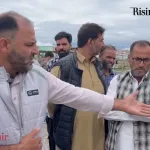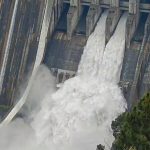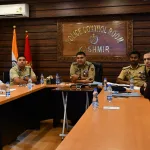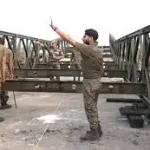NATIONAL POLICE DAY
The humans, kept at the highest pedestal of evolution by ‘Charles Darwin’ the famous scientist known for his theory of ‘Survival of the fittest’ are always in a state of flux constantly trying to come to the grips of change wrought by the tide of time and events. Collectively forming a society, humans need peace of mind and a conducive atmosphere to progress. Disturbed and anarchic societies dissipate themselves to no end. Ordered to fall in line and conform to the change dynamics of the world requires an organization fit enough to ensure a sense of security, safety, and order in a society.This is where the role of police comes into play to shield, protect and direct the energies of a society in a constructive and calibrated manner. The term police has been derived from the Latin word ‘Politia’ which means the condition of a state. The term inter alia means a system of regulations for the preservation of order, and regulation of law of the land.Policing is the science of maintaining peace & order in an ever changing society as mentioned above. Therefore policing philosophy, methods and attention of those responsible for the policing of society remains uppermost in the minds of mandarins of power.
Hence the topic of my present write up which lays stress on policing as viewed from the prism of a modern India which has undergone tectonic changes since independence. History of Indian policing on modern lines dates back to the dawn of the 19th century. The idea of a regular police force as it exists today was never in consideration before the British period and for a considerable time even after the commencement of the rule. It was only in 1774 that ‘Warren Hastings’ introduced for the first time under the company’s rule several measures for police reforms which lasted and later on culminated in the ‘Police act of 1861’. This system was based on three major principles as under—
- The police must be completely separate from the army.
- They must act independently as a body.
- Assist the collectors in the administration of law and order in their area of responsibility.
Be that as it may, the ‘National police day’ is however celebrated every year on 21st of October with full pomp and show off course tinged with a sense of solemnity. It remembers the sacrifice of the 10 policemen who were martyred in the line of duty on the present eastern Ladakh boundary with our adversary i.e. China. At a place called as ‘Hot springs’ in eastern Ladakh located between 15000 to 16000 feet, on 20th October 1959 three parties of police were launched for an area reconnaissance mission. Two parties of this mission returned safely having executed their task with no sign of the third party. It fell to the lot of the third party a day after on 21st October 1959 to take up the onerous task of locating the missing persons. A strong team under DSP/DCIO Shri Karam singh left their base for the task but were caught off guard after some time by the Chinese army due to absence of any cover. Caught in the open the party was bombarded by Chinese grenades causing injury to 7 persons with 10 reported deaths. The bodies of these 10 dead Indian police men were detained by the Chinese and returned after 3 weeks of hectic negotiations at the Karakorum pass along with the injured personnel in a very bedraggled condition. They were later cremated with full dignity at Hot springs by the Indian police. It is pertinent to mention here that way back in the 50s the indo -China border management task was delegated to a mix of authorities with actual foot patrolling and surveillance being undertaken by the police forces under the ministry of Home Affairs and superintendence of these activities under the overall command of the MEA (Ministry of external affairs), not a healthy mix with China being the adversary across the Himalayas. It was only this incident and another one in the eastern sector at a place called as ‘Longju’ in 1959 that the GOI did a serious rethink of its border management policy prompting it to hand over the onerous task to the Indian army as such.
Cutting back to the present times the police is a state governed subject falling within the gambit of 7th schedule of List II of the constitution of India (1861 police act). State draw rules, regulations and guidelines for the police in the state police manual. The organization structure in the police forces of the country is fairly uniform in all the states which I will not dwell much into this article of mine. The reader is well aware of the command and control structure in our police forces too. In addition to the above each state has two streams of police forces i.e. the civil police and the state armed police force with the later augmenting the police effort in case of serious breach of security to include communal riots, major natural disasters often supplemented by the SDRF (State disaster relief force) as the case may be. The country has on its rolls a parallel police force in the form of CPOs i.e central police force to include ITBP, BSF, CRPF, Assam rifles, SSB to name a few with its remit and charter strictly under the purview of the central government. While India is renowned as the world’s largest democracy, little is known about how it has managed police to such a large, complicated and unpredictable nation ready to erupt any moment on issues ranging from cow slaughter, Hindu- Muslim riots, and language divides, to farmer’s agitation etc. Some of the problems being faced by the police forces in modern times of the country are –
Overburdened forces and vacancies
There are several vacancies in the state police forces and some CPOs which occur from time to time. If I take the data of the year 2020, then overall sanctioned strength of the force was little more than 25 lakhs with about 25% vacancies (625000). This high percentage of vacancies results into a very high problem of overworked officers on ground. Given India’s low police strength per lakh population in comparison to international standards, each police officer is also responsible for a huge group of people. India’s sanctioned strength of police is 181 per lakh compared to the UN’s suggested standards of 222 police per lakh of population. AS a result there is a pendency of cases in all the police stations of the countrysomething of the similar nature is happening at the supreme court of India.
Infrastructure
Modern policing methods necessitate effective communication, cutting edge or modern weapons and a high level, of mobility. On numerous counts the CAG and the BPRD (Bureau of police research and development) have found flaws. The weapons in use by the beat sentry on ground is a pathetic Lee Enfield .303 bolt action rifle which are no match to the sophisticated weaponry fielded by the ultras. Leaving aside the police of Jammu and Kashmir rest all the police forces are still grappling with their bolt action rifles. The CAG discovered that numerous police forces across the country had very lengthy and bulky purchasing procedure for the fire arms, resulting in scarcity of arms and ammunition. Police vehicles are in short supply with an equal short supply of good drivers on ground.
Pole Net (Police Telecommunicatioin Network)
The central Govt had in 2002 sanctioned the project of POLENET for the country’s police and paramilitary communication based on a satellite that will be a faster way of communicating with each other. Unfortunately that is lying in a state of dereliction and in a state of disuse in many states. The underutilization of money is a big red flagging done by the CAG.
Relationship between Police and the Public
Effective policing is very important to build trust between people and the public. More trust deficit has to be removed between the two parties to be of any use.
Investigation of Crime
Police forces of India still rely on the archaic system of investigation of a crime scene. This has to change. They do not have the necessary training to be armed for such a highly digital and sophisticated society as found obtained in our country nowadays. Mid-course transfers of police offices in a crime scene is another bane to be tackled head on to make the system more responsive.
Police Accountability
In a country as diverse like India the accountability chart is more or less absent from our police force. Constant political interference, threat of punishment postings, bad working conditions all combines to make the accountability factor a misnomer.
Some of the solutions which can be a panacea for the above ills could be the following:
- Community policing policy.
- Specialized investigating units.
- Limiting the political executive’s superintendence over police forces.
Following the directions of supreme court’s orders with regard to a case of Prakashsingh vs Union of India (2006) It says the following…
- Every state should have a state security commission to set policies regarding its police forces operations, review police performances, and ensure the state does not exert pressure on the force to exert undue influence.
- Police complaints authorities should be given more powers to have their say in such matters.
- Separate the investigative and law enforcement officers which are commonly intermixed.
- Have more integrated training of the paramilitary forces with in the area of their responsibility to avoid mass casualties which have been the order of the day in Mao infested areas.
The current state of affairs in the country calls for an integrated approach to sort out the multi level threats ranging from Jammu and Kashmir to Chhattisgarh to Nagaland and Manipur. All these estates have been in the throes of militancy for the last so many decades. Time for the police force to not waste time. As Kiran Bedi said….Those Who Don’t Take Charge of Time, Time Lathi Charges Them.!
(The Author is a retired army officer and writes regularly for RK. Email: [email protected])





